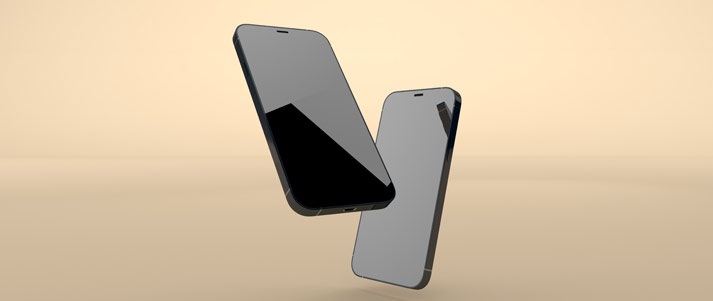Buying refurbished mobile phones
Want the savings of a second-hand phone, but with all the assurances you get from buying one brand new? Refurbished phones could be exactly what you're looking for.

Credit: Prostock-studio (foreground), Illus_man (background) – Shutterstock
If you're in the market for a new mobile, refurbished phones are well worth your consideration. The savings can be huge, with iPhones in like-new condition selling for over £100 less than the RRP. There are even bigger discounts available on other phones in other conditions.
Buying a refurbished phone is also a great way to reduce your carbon footprint (by about 80kg*). A single refurbished phone also saves 77,000 litres of water*, which is enough for you to drink your recommended two litres of water a day, every day, for around 105 years.
Read on to find out everything you need to know when buying a refurbished phone, plus the best places to shop.
What's in this guide?
What is a refurbished phone?
Think of a refurbished phone as a halfway point between a new device and a second-hand one from a private seller.
When you buy a second-hand phone from a private seller, there's always a risk it'll be broken or won't work as it should. This isn't to say that private sellers are dishonest – it's just that they may not be aware of some of the issues that can arise with a phone.
Refurbished phones are usually second-hand. However, the crucial difference is that they've been put through a series of tests to prove that they're still in full working order.
Among other things, refurbished phones have usually been tested to make sure that:
- The battery is in good health
- The buttons still work
- The screen is still fully responsive
- The phone still connects to WiFi and data networks.
All data on a refurbished phone will also be wiped before it's sold, so it'll be just like booting up a brand new phone when you buy one.
On the downside, buying a refurbished phone may mean you miss out on the original packaging. In some cases, this could also include accessories, like headphones. If these things are important to you, check with the retailer before making a purchase to avoid any nasty surprises.
Refurbished phone grades
Although there's no universal standard, refurbished phones are typically given one of the following grades to describe their condition:
- Grade A – These phones may as well be straight off the production line. They'll have no signs of wear and tear (or very, very minor ones at most), hence why this grade is usually known as 'Like New' or 'Pristine'.
- Grade B – This tier is often called 'Very Good' or even 'Excellent'. The phone will have some minor visible damage like small scuffs or scratches, but nothing huge.
- Grade C – Refurbished phones in this grade (also known as 'Good' or 'Fair') will have noticeable signs of wear and tear, like scratches and dents.
No matter what grade the phone is, the phone should still be in good working order. Usually, the grading only refers to the physical appearance of the phone, not the technical condition.
And remember that there's no universal standard. Some retailers will include the technical condition in the grading, some will have four grades, while others will define each tier slightly differently.
You should always check the specific definitions for each grade on whichever refurbished phone website you use.
Best places to buy refurbished phones
These are the best places to buy a refurbished phone:
-
4Gadgets
- Cheapest delivery – Free next day delivery
- Warranty cover – 12 months (full T&Cs)
- Returns period – 30 days (full T&Cs)
- Student discount – None.
-
Amazon
This information refers to third-party sellers on Amazon.
- Cheapest delivery – Free (but varies by seller)
- Warranty cover – Varies by seller
- Returns period – 90 days (full T&Cs)
- Student discount – Six-month free trial of Amazon Prime Student.
-
Back Market
- Cheapest delivery – Free (but varies by refurbisher)
- Warranty cover – 12 months (full T&Cs)
- Returns period – 30 days (full T&Cs)
- Student discount – £20 off everything on the website (once a year for any purchase over £250).
-
eBay
- Cheapest delivery – Free (but varies by seller)
- Warranty cover – Varies by seller
- Returns period – Varies by seller (not all will accept a return if you've simply changed your mind), but you are covered by eBay's Money Back Guarantee if there's an issue with the item (full T&Cs)
- Student discount – None.
-
Envirofone
- Cheapest delivery – Free next day delivery
- Warranty cover – 12 months (full T&Cs)
- Returns period – 30 days (full T&Cs)
- Student discount – None.
-
giffgaff
- Cheapest delivery – Free next business day delivery
- Warranty cover – 12–24 months, varies per phone (full T&Cs)
- Returns period – 21 days (full T&Cs)
- Student discount – None.
-
Mobiles.co.uk
- Cheapest delivery – Free next day delivery
- Warranty cover – 12 months
- Returns period – 14 days (full T&Cs)
- Student discount – Various.
-
musicMagpie
- Cheapest delivery – Free
- Warranty cover – 12 months (full T&Cs)
- Returns period – 14 days (full T&Cs)
- Student discount – 10% off.
-
Reboxed
- Cheapest delivery – Free
- Warranty cover – 12 months (full T&Cs)
- Returns period – 30 days (full T&Cs)
- Student discount – £20 off.
We haven't featured them in this list, but phone manufacturers will often also sell refurbished devices. You can usually find information on their official website.
Apple and Samsung both sell refurbished phones and buying a mobile this way means you can rest assured that the manufacturer itself is happy with the refurb. However, the reason we've left them out is that despite being cheaper than buying a new phone, they're usually more expensive than shopping with one of the companies above.
You can also buy refurbished phones through mobile networks. O2 Like New is just one example, but regardless of the network, you can typically only buy these devices on contract. Again, this is a more expensive option, as it's almost always cheaper to buy a phone separately and get a cheap SIM only deal.
Tips for buying a refurbished phone
Here's what you need to know before buying a refurbished phone:
-
Decide what condition you need

Credit: Diego Maravilla – Shutterstock
Although they're all second-hand phones, refurbished devices come in a range of conditions.
We've listed the broad refurbished phone grades above, but there is something for everyone. The biggest savings come with phones in the lowest grade, while the handsets in better condition are more expensive (shock).
However, even refurbished phones in the best condition are still considerably cheaper than buying a brand new device.
At the time of writing, Apple was selling a new iPhone 13 (128GB) in blue for £599. But when we checked musicMagpie, the same phone was available in 'pristine' condition (i.e. as good as new) for £504.99. Meanwhile, an equivalent device in 'good' condition was going for even less, at £424.99. That's a saving of between £94.01 – £174.01, depending on the grade.
Ultimately, it's up to you how bothered you are about cosmetic damage to your phone. Just remember that, with most refurbished phone sites, the grading only refers to the appearance of the device. It's worth considering whether you'd be happy to put up with some scuffs and marks to save a lot of money on a phone that works just as well.
As we said earlier, a few refurbished phone sites will include technical performance in their grading systems. Always check their definitions before assuming otherwise. -
Buy a refurbished phone at the right time
It's usually pretty hard to find a refurbished version of the latest model. Instead, you'll often have to settle for last year's edition. If the most recent Apple device is the iPhone 15, the newest refurbished device will probably be the iPhone 14.
But the longer it's been since a phone was released, the more chance you have of finding a refurbished version. At the time of writing, we found a couple of refurbished Google Pixel 7a devices available, despite the phone only launching several months earlier.
Arguably, the best time to buy a refurbished phone is when the manufacturer releases a new model. At this point, lots of people will be trading in their old devices for an upgrade, meaning the refurb market gets a huge intake of fresh stock.
As well as newer models suddenly being available to buy refurbished, it should also mean that older models drop in price.
In short, if you have a particular type of phone in mind, do some research and find out when the next edition is set to be released. Waiting until then could save you a lot of money.
-
Check the battery life
There are very few things as frustrating as owning a phone with awful battery life. When buying second-hand, you'll need to be careful!
Batteries wear over time, and while refurbished phones should have had theirs tested before going on sale, they might not meet your standards. If battery life is important to you, check the health of the battery early enough to send the phone back within the returns period if needed.
If it's an Apple device, simply go to Settings > Battery > Battery Health. You should be given a percentage score to tell you how strong the battery is compared to a brand new device. For example, a score of 95% means that when your phone says it's 100% charged, it's only charged to about 95% of what a new phone would be.
Things are a little trickier on Android. You may find that your phone's settings won't reveal the battery's health, or that you'll get a vague result like 'good', 'average' or 'poor'. If that's the case, we recommend downloading an app like AccuBattery. This can tell you exactly what the current battery capacity is compared to its designed amount.
Lauren Nash, Save the Student's Digital Marketing Manager, said:

For me, this is a big tip. In fact, Apple themselves suggest replacing the battery once it gets to 79%, as it can shut down the phone at random points.
When I bought a refurbished iPhone, the battery score was just 83%, so I sent it back.
I ordered a new one, again in the same condition that was listed on the website, and the battery health was showing as 93%. I was happy with that, and even happier that I'd thought to check in the first place.
-
Check for any other faults
Despite going through tests to ensure that they're in good working order, refurbished phones are still second-hand. There's always a small chance that some underlying problems could arise, so keep an eye out.
And don't be afraid to make a complaint if you think the condition doesn't match up with their grading system. These things can be down to interpretation, but if you've bought a phone that was meant to be in 'pristine' condition and find it has noticeable scratches on it, you should have a solid case.
In any case, check out the returns and warranty policies on the website you bought from. Make sure you're aware of what's covered, so you know if and when you'll be able to get a refund or exchange.
-
Use cashback websites

Credit: Sharaf Maksumov – Shutterstock
As with any online purchase, cashback sites should be one of your first ports of call when you're deciding where to buy a refurbished phone from.
In case you're unaware, when you shop through websites like TopCashback and Quidco, you can earn some money back on your purchase. This is usually a percentage of your spend (typically about 5%), but it can be a set amount too.
The shopping experience is exactly the same on your end. All you need to do is click through to the refurbished phone retailer from the cashback site and voilà, they should track the purchase.
Check out our guide to the top cashback websites to find out more. Always check which retailers are offering the best rates before making a decision.
-
Look for special discounts and offers
As if cashback, student discounts and the original savings on refurbished phones weren't enough, there are often special offers available too.
Retailers will sometimes run seasonal offers, and you'll usually be able to find discount codes online as well.
In fact, one of our team members managed to save £75 by buying a refurbished phone in a sale, plus an extra £15 by using a discount code. That's a massive £90 saving on a phone that's already cheaper than it should be!
In the past, we've also had exclusive discounts on refurb phones. Keep an eye on our deals section to see if we have one right now. Or, failing that, Google is your friend.
-
Get a cheap SIM only deal
We shared this tip earlier, but it's worth repeating. If you can afford to buy a phone upfront, it's almost always cheaper to do this and get a SIM only plan than it is to get one on contract.
There are some limited cases where a contract works out cheaper, but it's pretty simple to work out what the best option is. All you need to do is calculate the lifetime cost of a contract and then compare the numbers.
Let's use the example of a phone that's available on a 24-month contract for £30 a month, with a £50 upfront fee. 24 months of £30 payments bring us to £720, and when we factor in the £50 upfront fee, the lifetime cost of the phone is £770.
Now, let's imagine you can buy the same phone, in the same condition, for £450. And let's say that you can get a SIM for £8 a month (not hard to find with our list of SIM only deals), with the same allowances as the contract phone.
Over 24 months, that SIM will cost just £192, which makes the lifetime cost of this package £642. That's a saving of around £130 over two years. And, unlike a phone contract, you can cancel a short-term SIM only plan whenever you want. That way, there's no risk of continuing to pay for something you already own.
-
Sell your old phone
Don't forget that you can effectively reduce the cost of your new phone even more by selling your old handset.
We'd recommend waiting until you're confident that you're happy with your new device before doing this, just in case you need to send it back. But, once you're settled, you can make some extra money by selling your old phone.
When buying a refurbished phone, you may find that the retailer offers to reduce the price if you trade in your old device. While this makes it cheaper to buy the phone upfront, it's far from the best option for you and your money.
The rate they'll offer you is almost certainly less than you could get by selling it yourself. Selling on Facebook Marketplace or on eBay cuts out the middle man and maximises your profit.
You can also use some of these websites for selling your old phone (some of which also sell refurbished phones). This tends to be a less profitable option than selling it yourself, but it's definitely quicker. Plus, as some sites recycle the devices they receive, you're basically making money from recycling.
Whichever way you decide to sell your old phone, just make sure you've assessed your options first to check you're getting a good price!
If you're only after a new phone because your current one is full, put your money away and check out these tips for freeing up space on iPhone and Android.
* Source ADEME 2022, via Back Market.

















